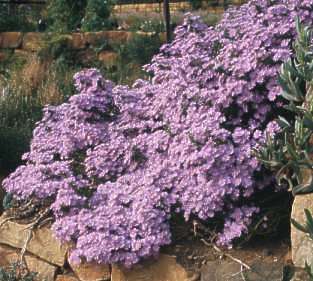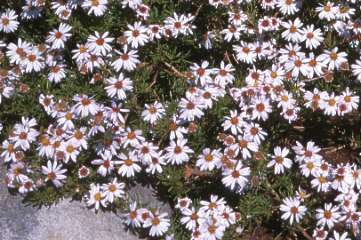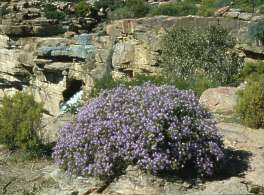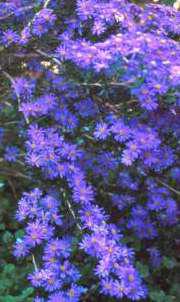Felicia filifolia subsp. filifolia
Felicia filifolia (Vent.) Burtt Davy subsp. filifolia
Family: Asteraceae
Common names: fine-leaved felicia, needle-leaved felicia, wild aster (Eng.); draaibos (Afr.); sehalahala-seseholo (Southern Sotho)
Introduction
When in flower Felicia filifolia is an eye-catching mass of mauve flowers with pretty yellow centres that will create a stunning splash of colour in your garden.

Description
Description
A well-branched, rounded, twiggy shrub that grows moderately fast and reaches a height of 0.6-1 m. The characteristic foliage consists of tufted clusters of fine, needle-like leaves from which the plant derives its name. In spring (October to December), the plant bears masses of daisy-like flowers which, from plant to plant, can range in colour from purple to mauve to white. The seedheads are fluffy and creamy white in colour. There are three other subspecies of Felicia filifolia.

Conservation Status
Status
Felicia filifolia subsp. filifolia is assessed as Least Concern (LC) on the Red List of South African Plants.
Distribution and habitat
Distribution description
The natural distribution of Felicia filifolia occurs in both summer and winter rainfall areas, from Namibia to Namaqualand, throughout the Karoo and the Cape region, the Free State, and as far as the northern provinces. It is most often found in rocky places on hillsides or mountainsides.
This Felicia is frost hardy and will tolerate a wide range of temperatures and watering regimes.

Derivation of name and historical aspects
History
Felicia is named after Herr Felix, a German official who died in 1846; the generic name could also be derived from the Latin felix meaning cheerful, a reference to the bright flowers. The species name filifolia means leaves like fern fronds, referring to the fineness of the foliage. Other noteworthy members are Felicia echinata, F. elongata, F. heterophylla, F. bergerana, F. erigeroides.
There are more than 85 species of Felicia, both annuals and small herbaceous shrubs, found from Africa to Arabia.
Ecology
Ecology
The masses of slightly aromatic daisy-like flowers will attract butterflies, bees and many other pollen-seeking insects to your garden, which in turn will lure the insectivorous birds. For wind dispersal the seeds are small and light, each with a tuft of hairs that assist with floating.
Uses
Use
In rural areas Felicia filifolia is often used as firewood. It makes a beautiful, hardy, water-wise garden plant. It is poisonous to sheep.
Growing Felicia filifolia subsp. filifolia
Grow
This is a moderately fast-growing, water-wise plant requiring only moderate watering.

Plant it anywhere in the garden and it will grow in almost any light, well-drained soil--always add compost for best results. Although it will tolerate light shade for part of the day, flowering will be at its best if it receives full sun all day long.
It can be massed for best effect in a large bed, but individual plants make striking accent plants when in flower. Plant it in groups in an informal border, on terraces, or in a rockery, or use it to line the front of a shrub border, or as a low informal hedge for spring and summer displays. Felicia filifolia is easy to care for. Prune back lightly anytime but usually to best effect after the main flush of flowering, removing old flowers and nipping back growth tips to keep neat, to encourage new growth and a further batch of flowers. Compost regularly. If damaged by frost, the plant will grow again in spring, with only a slight delay in the flowering time.
Felicia filifolia is easily propagated from seed sown in March/April (late summer to early autumn) or September; it usually seeds itself freely and young plants can often be found nearby. It can also be propagated from cuttings or by root division in autumn.
References
- Eliovson, S. 1957. South African flowers for the garden. Howard Timmins, Cape Town.
- Joffe, P. 2001. Creative gardening with indigenous plants. A South African guide. Briza Publications, Pretoria.
- Joffe, P. 1993. The gardeners guide to South African plants. Tafelberg, Cape Town.
- Leistner, O.A. (ed.). 2000. Seed plants of southern Africa: families and genera. Strelitzia 10. National Botanical Institute, Pretoria.
- Pienaar, K. 1985. Grow South African plants. Struik, Cape Town.
- Pienaar, K. 1984. The South African what flower is that?. Struik, Cape Town.
- Pooley, E. 1998. A field guide to wild flowers of KwaZulu-Natal and the Eastern Region. Natal Flora Publications Trust, Durban.
- Powrie, F. 1998. Grow South African plants. National Botanical Institute, Cape Town.
- Van der Spuy, U. 1953. Gardening in South Africa. The flower garden. Rutica Press, Wynberg.
Credits
Cherise Viljoen
Kirstenbosch NBG
November 2004
Plant Attributes:
Plant Type: Shrub
SA Distribution: Eastern Cape, Free State, KwaZulu-Natal, Limpopo, North West, Northern Cape, Western Cape
Soil type: Sandy, Loam
Flowering season: Spring, Early Summer
PH: Neutral
Flower colour: Pink, Mauve/Lilac
Aspect: Full Sun, Morning Sun (Semi Shade), Afternoon Sun (Semi Shade)
Gardening skill: Easy
Special Features:
Horticultural zones











Rate this article
Article well written and informative
Rate this plant
Is this an interesting plant?
Login to add your Comment
Back to topNot registered yet? Click here to register.